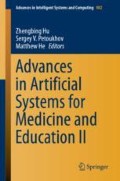Abstract
Is considered the mathematical model of the formation of the simplest artificial intelligence on the basis of the creation of difficult conditional reflexes with use of selective neural network technologies. A mathematical model based on complex third-order conditioned reflexes is practically implemented. Is substantiated the possibility of generalization of the mathematical model of artificial intelligence on the basis of the formation of complex conditioned reflexes of any nth order. The mathematical model of the formation of temporary connections at simultaneous inclusion of conditional and unconditional incentives is proved. This justification is based on the hypothesis of the formation of communication channels with each inclusion of conditional and unconditional stimuli and the formation of communication channels between the neural centers of conditional and unconditional stimuli. Are substantiated possible applications in the field of robotics, organization of intellectual speech, translation from foreign languages. Compares some of the theoretical approaches to the modeling of intelligence. A simple model of intelligence based on complex conditioned reflexes, using material devices that are implemented in the brain in the form of certain subsystems, is proposed. These subsystems are: ganglia, cerebellum, hippocampus, neocortex, and other subsystems. The proposed structural scheme of the model of intelligence, including the real material of the device.
Access this chapter
Tax calculation will be finalised at checkout
Purchases are for personal use only
References
Asratyan, E.A.: Ivan Petrovich Pavlov, p. 456. Science, Moscow (1974)
Asratyan, E.A.: Essays on the Physiology of Conditioned Reflexes, p. 360. Nauka, Moscow (1970)
Sechenov, I.M.: Reflexes of the Brain, p. 352. AST, Moscow (2015)
Anokhin, P.K.: Essays on the Physiology of Functional Systems, p. 447. Medicine, Moscow (1975)
Brynes, S.N., Napalkov, A.V., Svechinsky, V.B.: Neurocybernetics, p. 172. Izd. Med. Lit., Moscow (1962)
Gaase-Rappoport, M.G.: Automata and Living Organisms, p. 224. GIFML, Moscow (1961)
Gutman, : Dendrites of Nerve Cells Theory of Electrophysiology Function, p. 144. Mokslas, Vilnius (1984)
Jeffrey, C., Johnston, M., Johnston, D.: Plasticity of dendritic function. Curr. Opin. Neurobiol. 15(3), 334–342 (2005)
Mazurov, M.E.: Selective neural networks for the recognition of complex objects. In: Mathematical Biology and Bioinformatics: Proceedings VI International Conference, pp. 82–83. MAX Press, Moscow (2016)
Mazurov, M.E.: Neural selectivity in neural network systems, selective neurons and neural networks. In: Mathematical Biology and Bioinformatics: Works VI International Conference, pp. 84–85. MAX Press, Moscow (2016)
Mazurov, M.E.: A pulse neuron close to the real. Patent for Invention No. 2598298, 30 Aug 2016
Mazurov, M.E.: Neuron modeling the properties of a real neuron. Patent for Invention No. 2597495, 11 July 2014
Mazurov, M.E.: A single-layer perceptron based on selective neurons. Patent for Invention No. 2597497, 13 Jan 2015
Mazurov, M.E.: A single-layer perceptron modeling the properties of a real perceptron. Patent for Invention No. 2597496, 22 Aug 2016
Akkar, H.A.R., Mahdi, F.R.: Adaptive path tracking mobile robot controller based on neural networks and novel grass root optimization algorithm. Int. J. Intell. Syst. Appl. (IJISA) 9(5), 1–9 (2017). https://doi.org/10.5815/ijisa.2017.05.01
Mazurov, M.E.: Intelligent recognition of electrocardiograms using selective neuron networks and deep learning. In: International Conference of Artificial Intelligence, Medical Engineering, Education, pp. 182–198. Moscow, Russia (2017)
Anokhin, P.K.: Systemic Mechanisms of Higher Nervous Activity, p. 453. Science, Moscow (1979)
Anokhin, K.V.: Cognite: a hyper-network model of the brain. In: Proceedings of the 5th International Conference on Cognitive Science, Kaliningrad (2012)
Anokhin, K.V.: Neural mechanisms of memory: synaptic and genomic hypotheses. J. High. Nerv. Act. I.P. Pavlova 61(6), 660–674 (2011)
Chernavskaya, O.D., Chernavskii, D.S.: Naturally constructivist approach to modeling thinking. Biophysics 61(1), 201–208 (2016)
Chernavskaya, O.D., Chernavskii, D.S., Karp, V.P., Nikitin, A.P.: On the Approach to the Modeling of Thinking from the Standpoint of the Dynamic Information Theory. Sat. Ed. Redko, pp. 29–88. URSS, Moscow (2014)
Lashley, K.S.: The Role of the Mass of Nervous Tissue in the Functions of the Brain (1932)
Pribram, K.: Languages of the Brain. Experimental Paradoxes and Principles of Neuropsychology, p. 64. Ed. “Progress”, Moscow (1975)
Hubel, D.H., Wiesel, T.H.: Receptive fields, binocular interaction and functional architecture in the cat’s visual cortex. J. Physiol. 160, 106–154 (1962)
Mansor, M.A., Kasihmuddin, M.S.M., Sathasivam, S.: Enhanced Hopfield network for pattern satisfiability optimization. Int. J. Intell. Syst. Appl. (IJISA) 8(11), 27–33 (2016). https://doi.org/10.5815/ijisa.2016.11.04
Mishra, N., Soni, H.K., Sharma, S., Upadhyay, A.K.: Development and analysis of artificial neural network models for rainfall prediction by using time-series data. Int. J. Intell. Syst. Appl. (IJISA) 10(1), 16–23 (2018). https://doi.org/10.5815/ijisa.2018.01.03
Karande, A.M., Kalbande, D.R.: Weight assignment algorithms for designing fully connected neural network. Int. J. Intell. Syst. Appl. (IJISA) 10(6), 68–76 (2018). https://doi.org/10.5815/ijisa.2018.06.08
Akkar, H.A.R., Jasim, F.B.A.: Intelligent training algorithm for artificial neural network EEG classifications. Int. J. Intell. Syst. Appl. (IJISA) 10(5), 33–41 (2018). https://doi.org/10.5815/ijisa.2018.05.04
Lytvyn, V., Vysotska, V., Peleshchak, I., Rishnyak, I., Peleshchak, R.: Time dependence of the output signal morphology for nonlinear oscillator neuron based on Van der Pol model. Int. J. Intell. Syst. Appl. (IJISA) 10(4), 8–17 (2018). https://doi.org/10.5815/ijisa.2018.04.02
Awadalla, M.H.A.: Spiking neural network and bull genetic algorithm for active vibration control. Int. J. Intell. Syst. Appl. (IJISA) 10(2), 17–26 (2018). https://doi.org/10.5815/ijisa.2018.02.02
Author information
Authors and Affiliations
Corresponding author
Editor information
Editors and Affiliations
Rights and permissions
Copyright information
© 2020 Springer Nature Switzerland AG
About this paper
Cite this paper
Mazurov, M. (2020). Modeling of Intellect with the Use of Complex Conditional Reflexes and Selective Neural Network Technologies. In: Hu, Z., Petoukhov, S., He, M. (eds) Advances in Artificial Systems for Medicine and Education II. AIMEE2018 2018. Advances in Intelligent Systems and Computing, vol 902. Springer, Cham. https://doi.org/10.1007/978-3-030-12082-5_36
Download citation
DOI: https://doi.org/10.1007/978-3-030-12082-5_36
Published:
Publisher Name: Springer, Cham
Print ISBN: 978-3-030-12081-8
Online ISBN: 978-3-030-12082-5
eBook Packages: Intelligent Technologies and RoboticsIntelligent Technologies and Robotics (R0)

